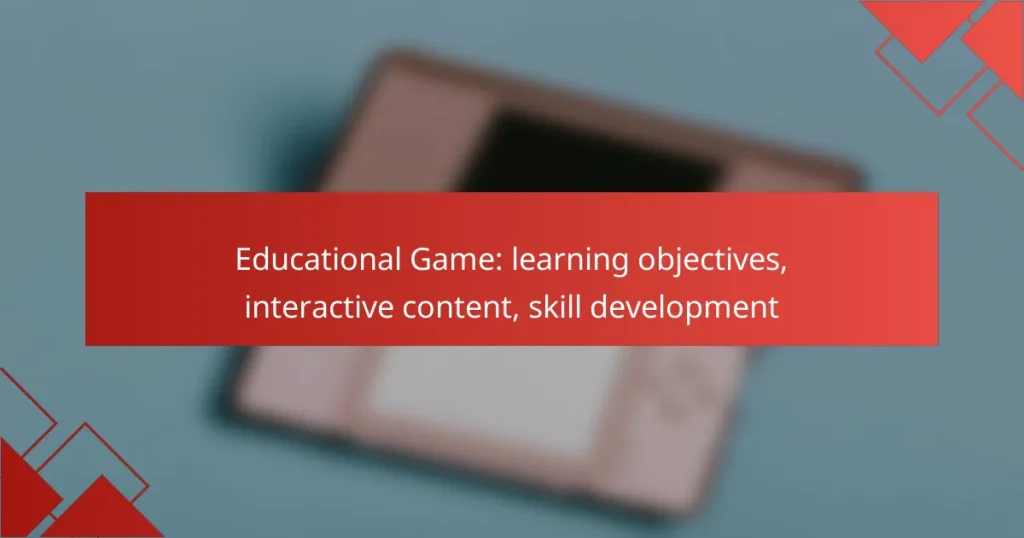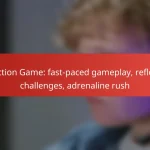Educational games significantly enhance learning objectives by making the educational process both engaging and effective. By integrating interactive content such as quizzes and simulations, these games not only reinforce concepts but also promote skill development in areas like problem-solving and communication.
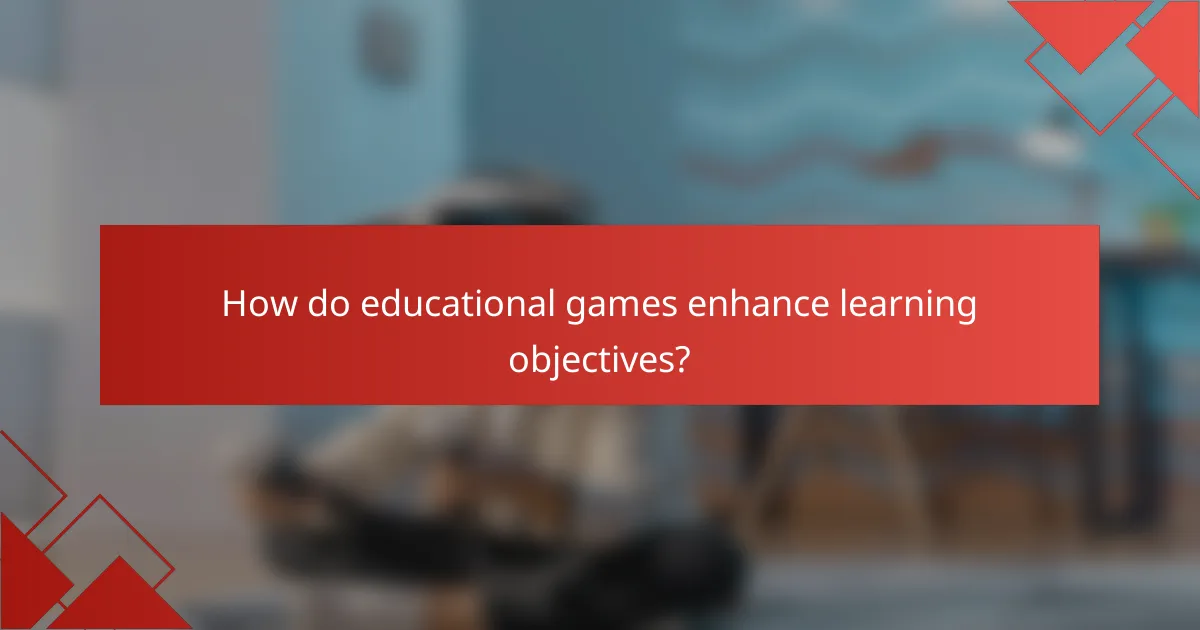
How do educational games enhance learning objectives?
Educational games enhance learning objectives by making the learning process more engaging and effective. They combine fun with educational content, which helps students grasp concepts better and retain information longer.
Improved retention of information
Educational games often employ repetition and active participation, which significantly boosts information retention. When learners interact with content through gameplay, they are more likely to remember the material compared to traditional study methods.
For example, a math game that requires players to solve problems to advance can reinforce concepts through practice, making it easier to recall them later. This method can improve retention rates by a considerable margin, often exceeding traditional learning techniques.
Engagement through interactive content
Interactive content in educational games captures students’ attention and keeps them motivated. By allowing learners to explore and manipulate information, these games create a dynamic learning environment that encourages curiosity.
For instance, a science simulation game that lets players experiment with chemical reactions can lead to deeper understanding and interest in the subject matter. This hands-on approach often results in higher engagement levels compared to passive learning formats.
Development of critical thinking skills
Educational games challenge players to think critically and solve problems in real-time. This process fosters analytical skills as learners must evaluate situations, make decisions, and adapt strategies based on outcomes.
Games that require strategic planning, such as resource management simulations, can enhance critical thinking by presenting complex scenarios that need thoughtful solutions. This skill development is crucial for academic success and real-world applications.
Promotion of collaborative learning
Many educational games encourage collaboration among players, fostering teamwork and communication skills. By working together to achieve common goals, students learn to share ideas and support each other’s learning journeys.
For example, multiplayer games that require players to solve puzzles collectively can enhance social skills and create a sense of community. This collaborative approach not only aids in learning but also prepares students for future group work in academic and professional settings.
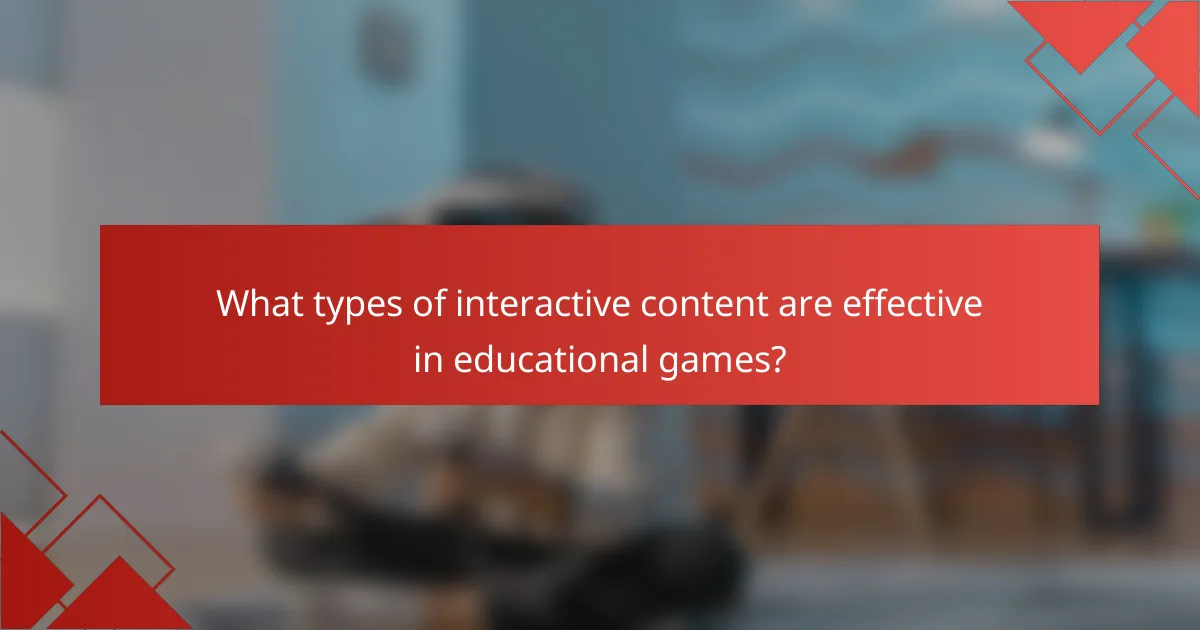
What types of interactive content are effective in educational games?
Effective interactive content in educational games includes elements that engage learners actively, such as quizzes, simulations, and story-driven narratives. These components help reinforce learning objectives and enhance skill development through practical application and immersive experiences.
Quizzes and assessments
Quizzes and assessments are essential tools in educational games, providing immediate feedback on learners’ understanding. They can be designed as multiple-choice questions, true/false statements, or fill-in-the-blank formats, allowing players to test their knowledge in a fun way.
To maximize effectiveness, ensure that quizzes are integrated seamlessly into the gameplay. For instance, a quiz could follow a challenging level, reinforcing concepts just learned. Aim for a balance of difficulty to keep players engaged without causing frustration.
Simulations and role-playing
Simulations and role-playing activities immerse players in realistic scenarios, allowing them to apply their knowledge in a practical context. These interactive experiences can range from virtual labs in science education to historical reenactments in social studies.
When designing simulations, focus on creating authentic experiences that reflect real-world challenges. For example, a simulation might involve managing a budget in a business game, teaching financial literacy through hands-on practice. Ensure that players receive guidance and feedback to enhance learning outcomes.
Story-driven narratives
Story-driven narratives engage players by weaving educational content into compelling plots. This approach not only captures attention but also helps learners retain information by connecting it to memorable characters and events.
To create effective narratives, develop relatable characters and scenarios that resonate with the target audience. For instance, a game about environmental science could involve a hero saving their town from pollution, encouraging players to learn about sustainability through the storyline. Keep the narrative relevant to the educational goals to ensure that learning remains the focus.

What skills can be developed through educational games?
Educational games can help develop a variety of skills, including problem-solving, communication, and time management. These games create interactive environments that encourage players to engage with challenges and collaborate with others, enhancing their learning experience.
Problem-solving abilities
Educational games often present players with complex challenges that require critical thinking and innovative solutions. By navigating these obstacles, players learn to analyze situations, evaluate options, and make decisions effectively. For instance, puzzle-based games can improve logical reasoning and analytical skills.
To maximize problem-solving development, choose games that progressively increase in difficulty. This allows players to build on their skills and face new challenges without becoming overwhelmed. Look for games that encourage experimentation and provide feedback on performance.
Communication skills
Many educational games require players to work in teams, fostering communication and collaboration. Players must articulate their thoughts, share strategies, and negotiate roles, which enhances their verbal and non-verbal communication skills. Games that involve role-playing or storytelling are particularly effective in this regard.
To enhance communication skills, engage in games that require discussion and teamwork. Encourage players to express their ideas clearly and listen actively to others. This practice can translate into improved interpersonal skills in real-life situations.
Time management
Educational games often have time constraints, pushing players to prioritize tasks and manage their time effectively. This experience can help players learn to balance multiple responsibilities and make quick decisions under pressure. Games with timed challenges can be particularly beneficial for developing this skill.
To improve time management, select games that incorporate deadlines or limited resources. Encourage players to plan their actions and reflect on their time usage after each session. This can help them identify areas for improvement and develop strategies for better time allocation in everyday tasks.

What are the prerequisites for implementing educational games in classrooms?
Implementing educational games in classrooms requires access to technology and adequate teacher training. These prerequisites ensure that both students and educators can effectively engage with and benefit from interactive learning experiences.
Access to technology
Access to technology is crucial for the successful implementation of educational games. Classrooms should be equipped with devices such as tablets, computers, or interactive whiteboards that can run the games effectively. Additionally, reliable internet connectivity is essential for online games and resources.
Schools may consider budgeting for technology upgrades or seeking grants to improve their infrastructure. A typical classroom might benefit from having at least one device per student to maximize engagement and interaction.
Teacher training and support
Teacher training and support are vital for integrating educational games into the curriculum. Educators should receive training on how to use the games effectively and incorporate them into lesson plans. This training can take the form of workshops, online courses, or peer mentoring.
Support from school administration can enhance teacher confidence and encourage experimentation with new tools. Schools should aim to provide ongoing professional development opportunities to keep teachers updated on the latest educational technologies and best practices.
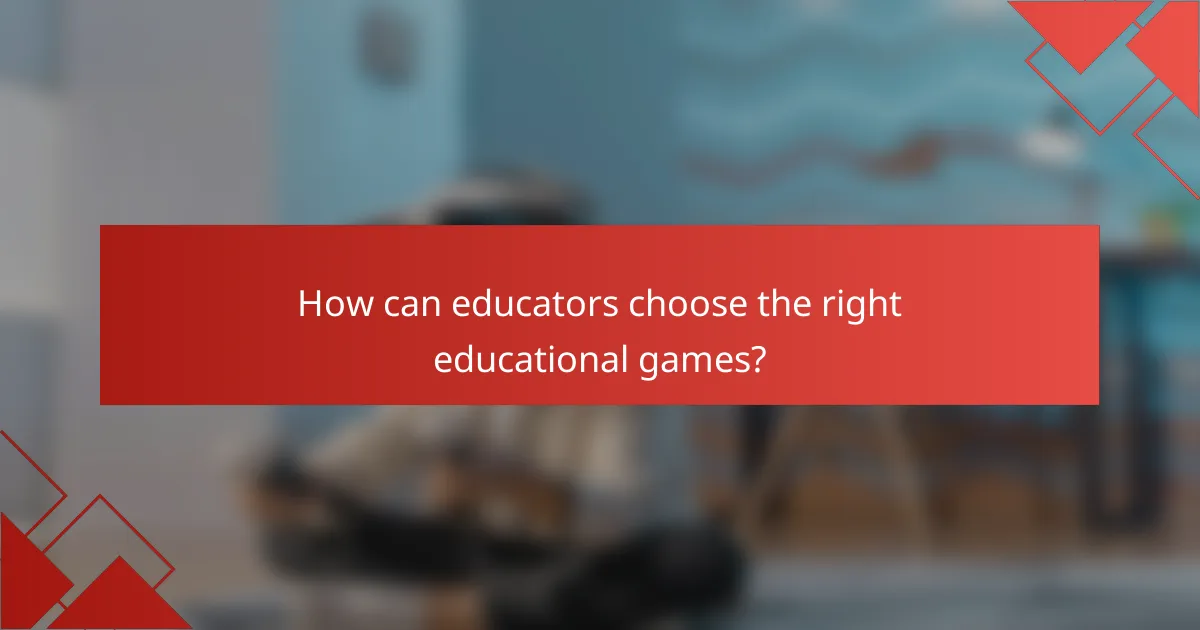
How can educators choose the right educational games?
Educators can choose the right educational games by ensuring they align with learning objectives and engage students effectively. Selecting games that meet curriculum standards and are suitable for the age group of the learners enhances both educational value and student interest.
Alignment with curriculum standards
When selecting educational games, it’s crucial to ensure they align with established curriculum standards. This means the game should reinforce key concepts and skills outlined in educational frameworks, such as the Common Core State Standards in the United States or the National Curriculum in the UK.
To evaluate alignment, educators can review the game’s objectives and content against their curriculum goals. For example, a math game should cover topics like addition or fractions that are part of the grade-level expectations. Using a checklist can help assess whether a game meets these criteria.
Age appropriateness and engagement level
Choosing games that are age-appropriate is essential for maintaining student engagement and ensuring effective learning. Games designed for younger students often feature simpler mechanics and colorful graphics, while those for older students may incorporate more complex strategies and themes.
Engagement can be gauged through factors like interactivity, challenge level, and feedback mechanisms. For instance, a game that offers immediate rewards for correct answers can motivate younger learners, while older students might prefer games that involve critical thinking and problem-solving. Educators should consider testing games with a small group of students to assess their interest and suitability before full implementation.
